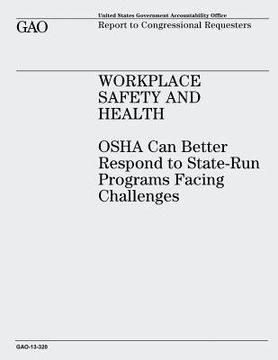Workplace Safety and Health: OSHA Can Better Respond to State-Run Programs Facing Challenges (in English)
Synopsis "Workplace Safety and Health: OSHA Can Better Respond to State-Run Programs Facing Challenges (in English)"
OSHA is generally responsible for setting and enforcing occupational safety and health standards in the nation's workplaces. OSHA carries out enforcement directly in 34 states and territories, while the remaining 22 have chosen to administer their own enforcement programs (state-run programs) under plans approved by OSHA. GAO was asked to review issues related to state-run programs. This report examines (1) what challenges states face in administering their safety and health programs, and (2) how OSHA responds to state-run programs with performance issues. GAO reviewed relevant federal laws, regulations and OSHA policies; conducted a survey of 22 state-run programs; and interviewed officials in OSHA's national office, all 10 OSHA regions, and from a nongeneralizable sample of 5 state-run programs; and interviewed labor and business associations and safety and health experts. State-run programs face several challenges that primarily relate to staffing, and include having constrained budgets, according to OSHA and state officials. States have difficulty filling vacant inspector positions, obtaining training for inspectors, and retaining qualified inspectors. Recruiting inspectors is difficult due to the shortage of qualified candidates, relatively low state salaries, and hiring freezes. Although OSHA has taken steps to make its courses more accessible to states, obtaining inspector training continues to be difficult. According to an agency official, OSHA's Training Institute faces several challenges in delivering training, including recruiting and retaining instructors, difficulty accommodating the demand for training, and limitations in taking some courses to the field due to the need for special equipment and facilities. These challenges are further exacerbated by states' lack of travel funds, which limit state inspectors' access to OSHA training. Retaining qualified inspectors is another challenge among states. Officials noted that, once state inspectors are trained, they often leave for higher paying positions in the private sector or federal government. GAO's survey of the 22 state-run programs that cover private and public sector workplaces showed that turnover was more prevalent among safety inspectors than health inspectors. Nearly half of these states reported that at least 40 percent of their safety inspectors had fewer than 5 years of service. In contrast, half of the states reported that at least 40 percent of their health inspectors had more than 10 years of service. These staffing challenges have limited the capacity of some state-run programs to meet their inspection goals. OSHA has responded in a variety of ways to state-run programs with performance issues. These include closely monitoring and assisting such states, such as accompanying state staff during inspections and providing additional training on how to document inspections. OSHA has also drawn attention to poor state performance by communicating its concerns to the governor and other high-level state officials. In addition, OSHA has shared enforcement responsibilities with struggling states or, as a last resort, has resumed sole responsibility for federal enforcement when a state has voluntarily withdrawn its program. Although OSHA evaluates state-run programs during its annual reviews, GAO found that OSHA does not hold states accountable for addressing issues in a timely manner or establish time frames for when to resume federal enforcement when necessary. In addition, the current statutory framework may not permit OSHA to quickly resume concurrent enforcement authority with the state when a state is struggling with performance issues. As a result, a state's performance problems can continue for years. OSHA officials acknowledged the need for a mechanism that allows them to intervene more quickly in such circumstances. GAO-13-320

